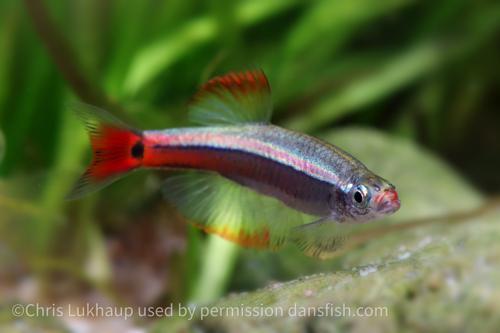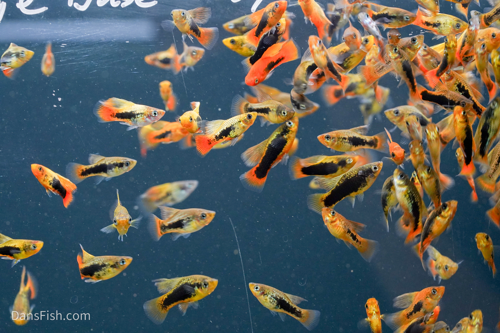Stock List
Out of stock items are listed at the end, they may be added to your wishlist and you'll be notified when they become available.

Celestial Pearl Danio - CPD
Price: $9.99
Available: 18

Platinum Rummynose Tetra
Price: $9.99
Available: 95

Pygmy Cory
Price: $11.99
Available: 370

Cardinal Tetra
Price: $9.99
Available: 333

Harlequin Rasbora
Price: $8.99
Available: 150

Rummynose Tetra
Price: $8.99
Available: 224

Corydoras sterbai
Price: $14.99
Available: 46

True Siamese Algae Eaters
Price: $9.99
Available: 128

Congo Tetra, Male
Price: $17.99
Available: 6

Lemon Tetra
Price: $8.99
Available: 250

Red Neon Blue Eye Rainbow
Price: $14.99
Available: 70

Orange Venezuelan Cory
Price: $14.99
Available: 330

Ember Tetra
Price: $6.99
Available: 180

Kuhli Loach
Price: $7.99
Available: 81

Long Fin Cherry Barb
Price: $14.99
Available: 65

Cherry Barb
Price: $7.99
Available: 95

Rainbow Shiner
Price: $12.99
Available: 2

Zebra Nerite Snail, (3 pack)
Price: $15.99
Available: 16

Reticulated Hillstream Loach
Price: $19.99
Available: 152

Black Otocinclus
Price: $24.99
Available: 6

Keyhole Cichlid
Price: $12.99
Available: 1

Neon Green Kubotai Rasbora
Price: $9.99
Available: 89

Dwarf Emerald Rasbora
Price: $9.99
Available: 62

Amano Shrimp, (4 pack)
Price: $24.99
Available: 33

Multi Shell Dweller Cichlid
Price: $16.99
Available: 31

Raccoon Tetra
Price: $14.99
Available: 2

Red Coral Teacup Platy
Price: $8.99
Available: 4

Marriage Kissing Medaka Ricefish
Price: $24.99
Available: 216

Gold White Cloud Mountain Minnow
Price: $7.99
Available: 67

Melanotaenia boesemani "Aves Creek"
Price: $25.99
Available: 24

Corydoras duplicareus
Price: $19.99
Available: 44

Painted Swordtail
Price: $7.99
Available: 11

Peacock Gudgeon
Price: $13.99
Available: 24

Melanotaenia sp. "Kali Tawa"
Price: $29.99
Available: 7

Bolivian Ram
Price: $19.99
Available: 58

Strawberry Rasbora
Price: $8.99
Available: 19

Red Cherry Shrimp, (4 pack)
Price: $19.99
Available: 27

Panda Cory
Price: $14.99
Available: 70

Phoenix Rasbora
Price: $8.99
Available: 4

Blue Shrimp, (4 pack)
Price: $29.99
Available: 39

Glowlight Danio
Price: $8.99
Available: 5

C123 Yellow Cory 'Rio Nanay'
Price: $19.99
Available: 104

Longfin White Cloud Mountain Minnow
Price: $9.99
Available: 119

Skiffia multipunctata 'Tangancicuaro'
Price: $13.99
Available: 4

Long Fin Super Red Bushynose Pleco
Price: $26.99
Available: 21

Roseline Barb
Price: $12.99
Available: 29

Betta siamorientalis
Price: $19.99
Available: 26

True Freshwater Bumblebee Goby
Price: $12.99
Available: 5

Red Wag Teacup Platy
Price: $8.99
Available: 55

Red Head Tapajos
Price: $29.99
Available: 26

Pearl Gourami VIRUS FREE
Price: $29.99
Available: 34

Dwarf Chain Loach
Price: $17.99
Available: 305

German Blue Rams
Price: $14.99
Available: 18

Turquoise Rainbowfish
Price: $18.99
Available: 33

Bamboo Shrimp
Price: $17.99
Available: 24

Super Blue Emperor Kerri Tetra
Price: $12.99
Available: 40

Stiphodon annieae Goby
Price: $29.99
Available: 5

Neon Blue Goby
Price: $12.99
Available: 217

Long Fin Corydoras paleatus
Price: $14.99
Available: 20

Lemon Blue Eye Bushynose Pleco
Price: $19.99
Available: 25

Pseudomugil gertrudae "Aru IV"
Price: $18.99
Available: 48

Dwarf Gourami: VIRUS FREE
Price: $19.99
Available: 7

Rainbow Goby
Price: $14.99
Available: 7

White Cheeked Goby
Price: $16.99
Available: 1

Albino Pygmy Cory
Price: $14.99
Available: 94
Red Onion Nerite Snail, (3 pack)
Price: $17.99
Available: 39

Assassin Snail, (3 pack)
Price: $9.99
Available: 42

Red Dragon Guppy, Pair (1M1F)
Price: $39.99
Available: 11

Santa Maria Endler, Pair (1M1F)
Price: $39.99
Available: 42

Costae Tetra
Price: $7.99
Available: 11

Feeder Snails, (10 pack)
Price: $9.99
Available: 25

Albino Threadfin Acara
Price: $29.99
Available: 46

Dwarf Neon Rainbowfish, Trio (1M2F)
Price: $39.99
Available: 3

L10A Red Lizard Whiptail Catfish
Price: $19.99
Available: 2

Exclamation Point Rasbora
Price: $7.99
Available: 2

Purple Mystery Snail, (3 pack)
Price: $17.99
Sale: $12.99
Available: 13

Nothobranchius rachovii, Pair (1M1F)
Price: $49.99
Available: 6

Rosy Loach
Price: $8.99
Available: 51

Gold Dust Earth Eater
Price: $24.99
Available: 10

White Cloud Mountain Minnow -WCMM
Price: $8.99
Available: 80

Goldeneye Dwarf Cichlid
Price: $13.99
Available: 26

CW010 Gold Laser Cory
Price: $29.99
Available: 56

Birdsong Goby
Price: $29.99
Available: 2

Alestopetersius sp. Red 'Lukenie River - Nioki'
Price: $24.99
Available: 16

Long Fin Rosy Barb, Male
Price: $14.99
Available: 10

Orange Shrimp, (4 pack)
Price: $22.99
Available: 64

Melanotaenia garylangei
Price: $26.99
Available: 11

Pseudomugil gertrudae 'Aru II'
Price: $29.99
Available: 18

Black Banded Sunfish
Price: $29.99
Available: 3

Bird of Paradise Platy
Price: $8.99
Available: 83

Pygmy Hatchet Fish 'Rio Momon'
Price: $8.99
Available: 37

Poso Yellow Rabbit Snail, (3 pack)
Price: $19.99
Available: 6

Chilatherina alleni "Wapoga"-Gary Lange Strain
Price: $15.99
Available: 3

Nothobranchius eggersi 'Ruhoi Red", Pair (1M1F)
Price: $44.99
Available: 8

Japan Blue Gold Double Swordtail Guppy, Reverse Trio (2M1F)
Price: $29.99
Available: 3

Redtail Goodeid, Pair (1M1F)
Price: $24.99
Available: 5

Corydoras hastatus
Price: $39.99
Available: 65

Tiger Teddy Livebearer, Pair (1M1F)
Price: $49.99
Available: 1

Really Red Pencilfish 'Rio Amaya', Male
Price: $69.99
Available: 30

Horseface Loach
Price: $12.99
Available: 86